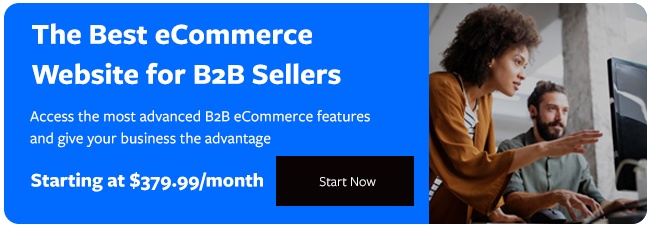
Is your business making use of the ecommerce opportunity at your fingertips?
When we talk about ecommerce, most of us imagine retail powerhouses like Amazon or Wayfair – but the B2B ecommerce potential is even bigger. In fact, the business ecommerce market topped $7.7 trillion in 2017. That’s a huge opportunity.
Why the popularity of ecommerce for B2B transactions? There are a lot of reasons for ecommerce’s growth in B2B sales, but the biggest reason isn’t so different from the B2C world: convenience.
It’s easier, faster, and generally less hassle to research, price, and place orders online. Plain and simple. If your B2B website isn’t set up for ecommerce yet, consider this your formal invitation!
B2B Ecommerce Best Practices
Just like any other online store, B2B ecommerce websites are as diverse as the businesses who build them. There are, however, a few common best practices that successful B2B websites need to follow. These must-do elements combine to give your online store the best chance at wild success.
Stellar Customer Experience
This first best practice applies to all ecommerce websites, but putting it into practice looks a little different for the B2B world.
Even when you’re selling to a business, there’s still a person on the other side of the screen. A person who has their own concerns and preferences. A person who makes purchasing decisions. That’s why it’s vital for all ecommerce sellers to prioritize providing A+ customer experience.
What does that mean for B2B sellers?
- Personalization & segmentation. Personalization is key for any website these days, but it’s absolutely fundamental to providing a good B2B ecommerce experience. With diverse businesses making large orders through your website, you need an ecommerce platform that enables you to segment customers and personalize the way you handle things like promotion, pricing, and order management.
- Transparent pricing. In the business world especially, price weighs heavy on purchasing decisions. You want a chance to prove your worth to potential customers, but making pricing information unclear or hard to find leads to a bad customer experience. Don’t be that website.
- Seamless navigation. We’ve already talked about how much research and comparison shopping goes into a B2B buying decision. That’s precisely why your website needs to make it easy as pie to find any information leads may come looking for. How? Simple, streamlined navigation.
Optimizing for B2B sales
B2B sales are fundamentally different from B2C purchases for a lot of reasons. All ecommerce websites aim to convert leads, but the methods we use to go from lead to customer are different. That’s why a successful B2B ecommerce website is optimized specifically for B2B sales. Above and beyond the best practices of ecommerce generally, there are a few other ways you can tailor your online store for B2B customers.
- The right customer service/support. With the longer B2B sales cycle, your emphasis has to be less on immediate conversion and more on long-term relationship building. Self-help customer support tools like knowledge bases and FAQs have their place, but there’s no substitute for two-way communication like live chat and phone support.
- Encourage repeat purchases. Repeat purchases happen in the consumer world, but standard reordering of the same items and quantities is a lot more common in the B2B market. That’s why your ecommerce store should make it radically quick and easy to complete routine orders.
- Educational content. The sales cycle for B2B is long – decision makers tend to do more research and comparison shopping than their B2C counterparts. Your goal is to make it easy for buyers to get the information they’re looking for. Educational content can help you do just that, all while nudging leads down the road to a sale.
Getting it Right
There’s no shortage of literature showing us what great B2C ecommerce websites look like. Some websites, like Amazon, are universally effective for all-around ecommerce. If you’re strictly in the B2B space, here are a few examples of other businesses getting it right with B2B ecommerce design.





Leave a reply or comment below